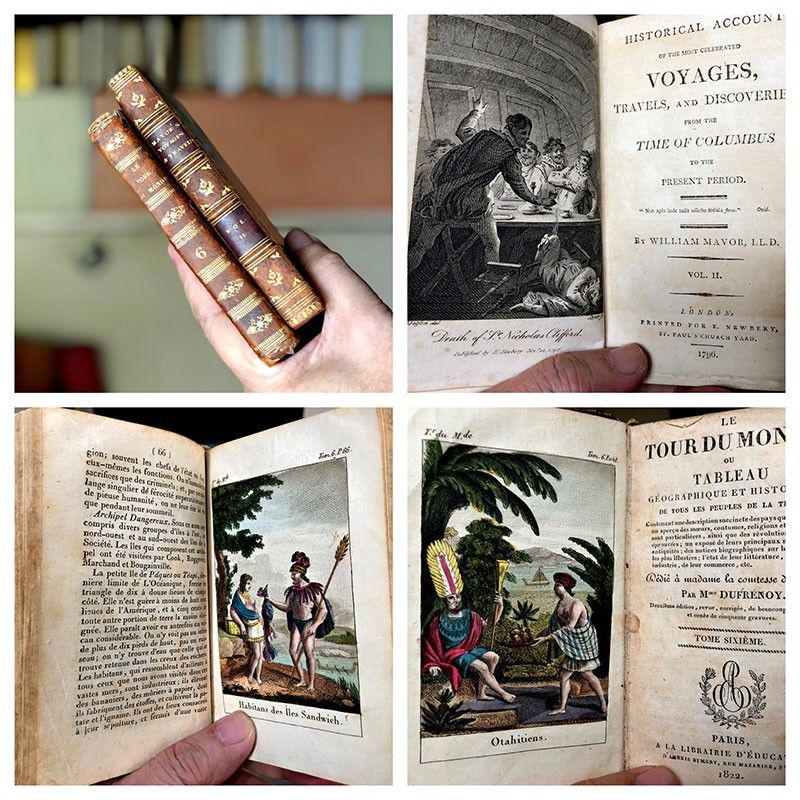Big stories in little books

Among the 50 pounds-plus of books that I carted home from my last visit to our daughter Demi’s place in San Diego, California, was a mini-stash of small leather-bound books that most people would probably ignore had they turned up in a yard sale. In a time wedded to the notion that bigger is better, small books attract scant attention, the impression being that they can’t have much to say.
To be honest, I didn’t know the size of the books at the time I ordered them; either I wasn’t looking too closely at the description, or was distracted by other features. My first reaction upon seeing them might have been disappointment, expecting to receive heftier volumes, especially given their topics, history and geography. But as soon as I opened them and began reading, my complaints melted away.
First, a short note about book sizes: publishers and librarians generally go by descriptions that range from the folio, the largest standard-sized book at about 12”, to the sexagesimo-quarto (or “64mo”) at 2”. Most books we buy today fall into the octavo (6” x 9”) or duodecimo (5” x 7-3/4”) category. My small books are octodecimo (4” x 6-1/2”) and smaller. (Miniature books—indeed, whole miniature libraries, one of which Napoleon was said to have carried to battle—have a fascinating history.)
The first little book I’d like to share with readers is Vol. II of Mavor’s Voyages and Travels, published in London in 1796. (For its age, its looks almost new, the leather supple and unmolested, except for wear at the corners, and the paper is bright and crisp.) The book offers contemporaneous accounts of the voyages of the great navigators and explorers of the 17th and 18th centuries — Drake, Cavendish, Raleigh, Van Noort, etc.—and they brought me back to my boyhood readings of these travels and their marvelous discoveries.
I haven’t finished the book, but so far I’ve found one reference to the Philippines, from Joris van Spilbergen’s voyage of 1614-1617:
“On the 6th of January 1616, they landed on one of the Ladrones, and reached the Manillas the 9th of February. On the 5th of March they received intelligence of a fleet, consisting of twelve ships and four gallies, manned with two thousand Spaniards, besides Indians, Chinese, and Japanese; which powerful armament was intended to drive the Dutch out of the Moluccas.”
More gripping is this episode from the round-the-world voyage of Willem Schouten and Jacob La Maire of 1615-1617, described elsewhere as “the greatest Dutch expedition into the Pacific Ocean,” a voyage mean to find a new route to the Spice Islands and Terra Australis, today’s Australia:
“They left the coast of Sierra Leona on the 4th of October; and next day, about noon, were surprised by a violent shock given to the lower part of one of the ships. No adversary appeared, no rick had been encountered; but while they were amused with this phenomenon, the sea began to change color, and a fountain of blood seemed to surround them. This sudden alteration of the water was no less astonishing than the shock they had sustained; but of the cause of the both they were equally ignorant, till they reached Port Desire. There, in careening the ship from the strand, they found a large horn, both in form and magnitude resembling an elephant’s tooth, sticking fast in the bottom of the ship. It was a firm and solid body, without any cavity or spongy matter in the middle; and had pierced through three very stout planks of the ship, and raised one of the ribs; penetrating at least a foot deep in the timbers, and about as much more appeared outside. The incident on the coast of Sierra Leona was now explained. It was clear that some monstrous tenant of the deep, of unknown species, having made a rude assault on the ship, was unable to withdraw its weapon; which, breaking in the attack, occasioned such an effusion of blood as to discolour the surrounding ocean.”
And Port Desire? Could a port be better named, from the viewpoint of a sailor months at sea, suffering from scurvy and all manner of loneliness and discomfort? (The port, now named Puerto Deseado, still exists in Patagonia in southern Argentina, and was visited by Charles Darwin on the Beagle in December 1833.)
Another small book comes from 1822, and it’s in French: Le Tour du Monde, ou Tableau Geographique et Historique de Tous le Peuples de la Terre. These “tour du monde” or around-the-world books were popular in the 19th century; I’ve chased after them out because they promise exquisite engravings, and this one didn’t disappoint, with hand-colored illustrations of life in Tahiti, Java, the Sandwich Islands, Peru, and Patagonia. No Philippines here, but since it’s the sixth volume in a series, I’m pretty sure the Philippine version will turn up soon.
Of course, much of this information could be available elsewhere at little or no cost; you don’t have to buy an 18th century book to see what it says, with websites like Project Gutenberg providing the full texts free of charge. But I choose to read not just for information, but for the romance of it — and there’s nothing like holding the very same book that a solicitor or a milliner would have sought for news and entertainment two hundred years ago.
There’s actually a few more small books in the pile, but we’ve run out of space, so I hope I’ve said enough to pique your interest in these tiny packets of wonder.
* * *
Email me at jose@dalisay.ph and visit my blog at www.penmanila.ph.



















